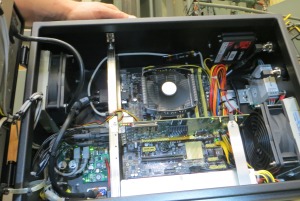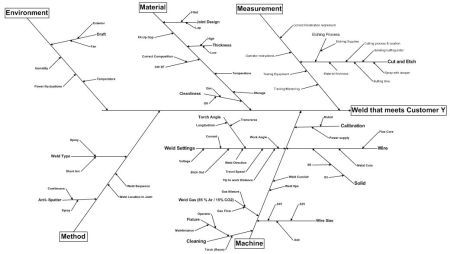How can you turbocharge your weld quality in mechanized welding? By viewing the weld, greatly magnified, with far greater clarity than possible with a welding shield, remotely from any location. How does this technology work, and why is it so much better? Cameron Serles’ blog post does a good job of explaining the basics of the breakthrough Xiris camera systems: http://blog.xiris.com/blog/bid/392061/How-to-Get-the-Best-View-of-an-Open-Arc-Weld
But beyond that, what about the hands-on opinion of an objective welding engineer? This is a first-ever hands-on review in Visionary Welding, and it’s a story worth telling. I was able to set up and demo a Xiris dual-camera setup in recent months with the help of the talented Cornelius Sawatzky, and coordinating aid from Machine and Welding Supply Company (Raleigh, NC branch, Mark Jeffries and Brent Ellis). I saw fantastic benefits for long multipass mechanized welds.
Here’s how I would cram the WOW into one paragraph: The screen perspectives are astonishingly good – so good that it makes you want to put a Xiris camera on your head and a smartphone screen in your helmet for doing manual welding. It’s like what you see on a dark cloudy night, vs. wearing night-vision goggles. It’s like the difference between what you can see, and what Superman can see – courtesy of logarithmic light intensity processing that lets you see the puddle, the arc, and the surrounding material all at the same time. You can toggle between auto-recording (when the arc is active), or manual recording modes. The ability to capture everything during a weld means that welder operator training can move ahead by a light-year, just by reviewing and using video segments to show ideal techniques, weld defects as they occur, and methods of error recovery which may avoid weld repairs.
In reviewing the welding videos that we made during a couple of days of production, several things stood out:
- The balanced location of the molten weld puddle has to be constantly monitored and frequently adjusted. The location needs to be adjusted not only to edges, but also to placement on the plane of the layer in planning for the width and sequence of beads that will effectively fill each required layer (and provide for post-weld machining to finish dimensions). Doing this relies on proximity line-of-sight, which is normally limited, restricted, and distant: generally poor. Everything seen through a welding helmet lens under these conditions is difficult to interpret and even harder to teach.
- Producing a perfect weld takes not only great interpretive visual skills but constant, non-distracted attention. Both of those were “bionically” enhanced while welding with the camera system.
- In historic mechanized welding, both the interpretive visual skills and this issue of non-distracted attention are not simply limited by the welder’s motivation: they are chained and blindfolded by the use of inadequately archaic manual technology. For example, the welder historically needs to peer through a welding hood and see the weld area clearly from more than one angle to properly interpret what is happening in the weld and in the joint. But, he cannot see everything clearly with only one lens shade, he can only get a second viewing angle by leaving the controls, and his eye is always at least three feet from the arc. So the welder functions in a world where everything is a compromise and he is limited to guesswork which is based on poor visual access, and a distant, squinting perspective.
- Many things can be done with a standard single-camera Xiris system. But through placement of two cameras, you can gain a view of both sides of the weld – giving the welder an instant and continuous advantage which they never had before. With a tap of your finger or glove, you can switch between three arrangements of the two views to maximize the advantages for the needs of the moment.
- “Supersize” the magnification advantage for the operator, or broadcast it to a wider, distant shop-floor audience by plugging in a big external flatscreen. (Could be a high value deal-closer for customer visits or Open House events?)
- The Xiris software provides the important ability to automatically adjust or manually “tweak” the image characteristics for maximum clarity advantages. After all, there are great differences between welding processes, weld parameters, materials, and joint configurations. But frankly, the results of activating the auto-adjust were hard to beat and as fast as a digital camera in Auto mode, making it obvious that Xiris has invested a lot of brainpower to make it easy to get optimal viewing results of the weld puddle and the entire welding area – at the same time. Finally, the focal point of the camera has everything to do with how clearly you can see what you want to see. But since these cameras have built-in focal-length motors and easy screen-tap changes of focal point, it’s fast to make on-the-fly adjustments to focal-length.
Considering these issues, it becomes more clear why Xiris’ dual cameras with logarithmic light intensity processing of magnified images is a gigantic enabler for weld quality perfection. Not only can the operator see the weld and surrounding areas perhaps 5 times better than even closeup through a welding shield, and not only is it magnified much larger, but he never needs to stand/squat/peer/duck/walk-around while leaving the controls to glimpse a different view. Because he is at the controls when he sees the first hint of a problem, and because he can interpretively identify it much sooner, he is able to adjust to avoid the problem – instead of recognizing and adjusting a few seconds after the problem is full-blown.
It is primarily the nuanced details occurring within the weld puddle motion, puddle placement, puddle shape and solidification profile that determine the quality of the weld deposit. Because of this, it seems inherent that giving the welding operator this 10-times improvement in detailed visibility (that’s an understatement) should reduce remote mechanized welding defects by at least 70 to 90%… but I suspect it can probably enable 95% defect reductions in many situations.
All considered, the system seems pretty cost-effective, with fast payback in many production environments. What’s the cost? Think “best new cars on a budget” without fancy options or extra-status badges and you’ll have an idea of the price range.
What about the Xiris equipment design and durability?
Well-engineered design seemed evident in almost every aspect of the Xiris equipment:
- Engineered and tested durability in high-temperature environments, using Exair chilled compressed air in the temperature-monitored camera housings, and optional high-temperature insulating wraps. Its’ tested camera/cabling capabilities can comfortably handle a 500F preheat environment when fully outfitted.
- Matured control console design, with cooling and filtration
- Durable high-performance cabling with sealed end connectors
- Intuitive software interface design, with graphic-symbol-driven screen layouts and screen swapping
- Simple yet thorough system documentation
- 3-layer password levels
- Our optioned higher-storage capacity unit provided about 130 hours of dual-camera weld-arc recording time
- Amazing pixel achievements in the clarity and value of the highly engineered weld imaging
- Continued improvement efforts in the software-use details
In summary, I found the Xiris system is designed to be easy to use, easy to maintain, and quite durable with reasonable care and use. How easy and intuitive was it to use? I had confidently selected and labeled a hardback notebook, knowing that I would need to take a number of important notes on how to accomplish and recall various Xiris tasks and tricks. I never do that, but I “knew” I would need it, and I wanted to “pick” Cornelius’ brain on such things. I had the notebook with me the entire time, but I could never identify anything that I needed to write down: that’s how easy and intuitive it is to use, and how thorough the short Xiris system manual is.
In short, this is disruptive, groundbreaking world class welding technology that’s not R&D: it’s ready for mainstream. My congratulations to Xiris on a fantastic product line that should prove to be a game changer in profits and weld quality in many automated or mechanized welding applications.




 Posted by Brian Dobben
Posted by Brian Dobben 

